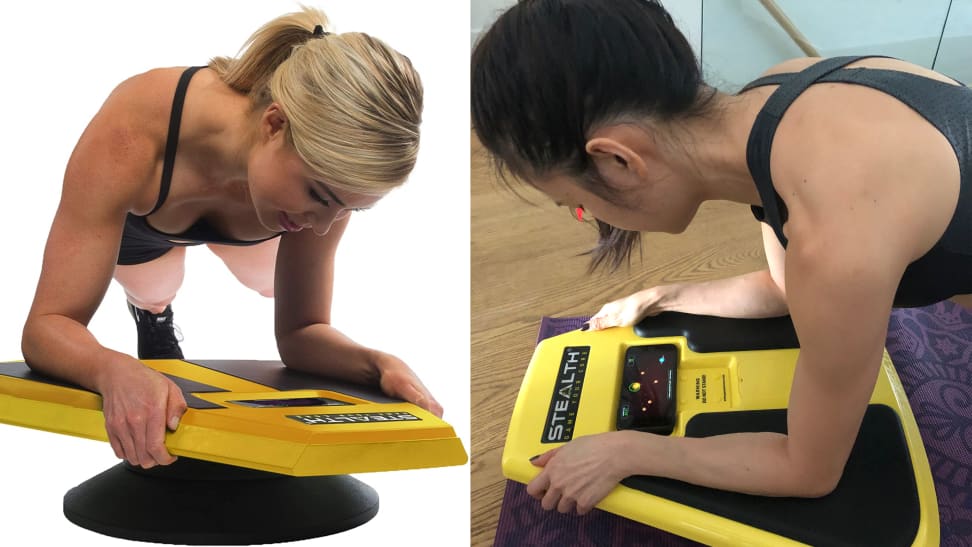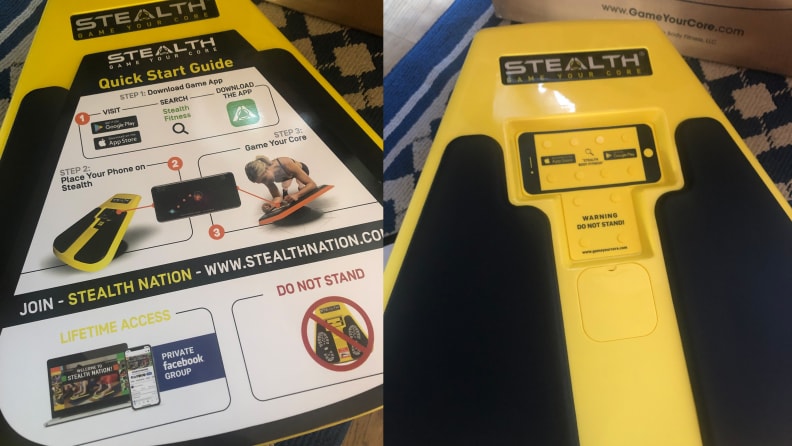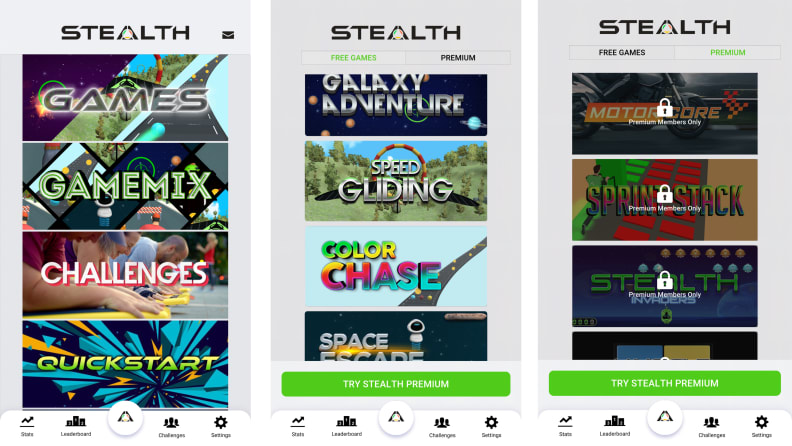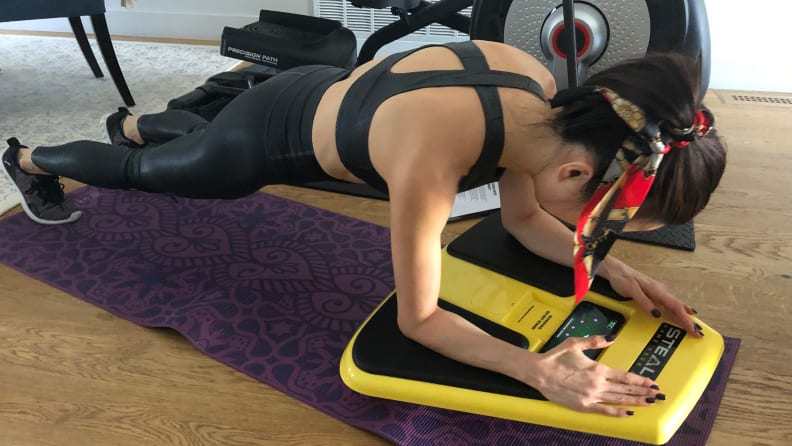We tried the Stealth Core Trainer—here's what to know about the planking device
The device lets you play games while you tone your abs—but does it work?
 Credit:
Stealth / Reviewed / Tiffany Leigh
Credit:
Stealth / Reviewed / Tiffany Leigh
Products are chosen independently by our editors. Purchases made through our links may earn us a commission.
[Editor's note: Some updates were made to this piece after publication.]
I’m a self-described “cardio-freak.” But after a lifetime of running and elliptical-ing, I’ve realized the importance of building strength, too, especially in my core. My go-tos have historically been yoga, pilates, and crunches paired with grueling planks. But a few months ago, I heard about something called the Stealth Core Trainer, a fitness contraption that makes planking fun by combining phone games with planks. My gut reaction (no pun intended): “Sure! Game on!”
Stealth sent me a loaner device to try out for a couple weeks. Ultimately, it isn’t my favorite piece of equipment, but it could still be a good option for some people. If you’re intrigued by the Stealth Core Trainer, too, here’s what you need to know.
What is the Stealth Core Trainer?

The Stealth has a spot for your phone and your forearms.
The Stealth Core Trainer is an exercise device that’s basically a balance platform, like the type you might see in a physical therapy office. The main differences are that this one has a spot to place your smartphone that you sync to the fitness company’s game-based app, and it’s designed exclusively for planking (and absolutely not standing on, per the stern instructions on Stealth's packaging). To use it, you set yourself up with your forearms resting on top of the foam pads, and your face hovering over the phone screen. This gives you a clear view of Stealth's games, which vary in format and goal—from blowing up planets in outer space to flying over a forest while avoiding collisions with birds—but all involve twisting, turning, and balancing to stimulate core muscles to engage.
The company offers three versions of Stealth that correspond with skill level, which cost $149 to $299 (depending on the model) with a 60-day trial. It recommends starting with the basic beginner model, so that's the one I got. It's made of hard plastic and has cushioned black pads for your forearms to rest upon, a recessed rectangular opening that can hold most smartphone models (which can be placed vertically or horizontally), and a patented “dynamic planking platform” that supports up to 300 pounds. This plastic board sits on a 360° “fluidity sphere’’ (which essentially looks and feels like a hard bowling ball with a flat platform on top of it) that allows you to twist and turn your torso while in a planking position. You can also get an advanced/professional model, which is a little larger and heavier, or a "deluxe" version of the beginner version, which has a platform that offers more padding around the sides and a larger surface area for your arms to rest on.
All three units have the same fitness objective: to strengthen your core muscles isometrically (i.e., by holding them firm and still). The benefits of planking are plentiful, according to Caleigh Rykiss, a trainer and CEO of BOLO Inc., a boutique fitness brand in Toronto. “Contrary to popular belief, [planks are] a full body exercise—not just an ab exercise,” she says. “When done properly they work the core, the quads, glutes, the back muscles, shoulders, and biceps, burn more calories, and are much more efficient [for targeting abs] than a crunch or sit-up. Planks help with good posture and strengthen the muscle fibers in between the abdominal muscles that help with balance and help keep your back safe when lifting heavy things.” Overall, she says, they're a functional exercise, “as in, they help us function better in our day-to-day lives.”
However, there are a few limitations. For one, like any single type of training, you can't get all the body benefits you need for well-rounded fitness from planking alone. (That is, you train planks and you get better at planks.) Rykiss adds that if you’re not mindful of your posture, you could injure yourself—especially if you arch your lower back during the pose, which could lead to strain and pain. With that in mind, she advises the following in acquiring the ideal posture: “I recommend starting on the knees and mastering a solid plank positioning there. Think: back flat, core pulled in, and butt tucked—and then working up to a plank from the toes.”
How do you use the Stealth Core Trainer?

Stealth's app gives you access to some free games—and a lot of ones you have to pay for.
Once you receive the device, you need to download the free Stealth Fitness app (via Google Play or Apple App store) onto your smartphone. The app home screen displays icons labeled “Games,” “Gamemix,” “Challenges,” Quickstart,” and “Stealth Nation.” There’s also a taskbar that allows you to navigate between your “Stats” (which tracks app usage), “Leaderboard” (which shows ranking of the top app users from the around the world) and “Challenges” (which allows you to connect with other Stealth users as you play).
The layout of the app doesn’t tell you what you should click first, but the “Quickstart” title makes it pretty self-explanatory as the place to begin. This is your essential field guide and includes all the how-to videos regarding the proper form to have on Stealth and how to use it. The app includes four free games, with two portrait-mode interfaces and two horizontal ones for how you should orient your phone. You click on your game of choice and it opens to a "quick instruction" pop-up screen on how to play it, then you select whether you want to play it as either an “endurance” game, in which the workout keeps going until you stop the game manually, or “countdown,” in which the game ends automatically after a preset time mode. The default countdown is a three-minute duration, but you can set it for whatever you want. You start the game, place the phone in the recessed console, and off you go!

The Galaxy Adventure game has you fly through space.
The app's classic arcade-style games are supposed to make those otherwise arduous planks more tolerable—and maybe even fun. One, Galaxy Adventure, puts you in outer space surrounded by planets and orbits. Your player icon is a green crosshair that moves as you twist, plank, and hold on the Stealth Core Trainer. With prompts guiding you, you either rock side to side to blow up the planets, tilt back and forth to hit fireballs, or twist left and right to destroy planets. You’re also asked to hold still on the plank at certain intervals, which helps you accumulate points. Another game, called “Speed Gliding,” has your player soaring through the sky over forested terrain. There are obstacles such as eagles, trees, and rocks you want to avoid (hitting them will slow you down). Additionally, you’ll encounter balloons and when you bump into them, the game will pause and prompt you to twist and hold your pose—after a certain amount of time, your player will be allowed to move again. The other space game, Space Escape, lets you play as a bouncing Wall-E-esque robot who's after diamonds, and Color Chase has you bounce around different colored dots, sort of like Candy Crush.
The “Gamesmix” section is if you’re bored with one game throughout your timed sessions and want the app to automatically switch it up every few seconds. The cerebral stimulation and constant change is supposed to make time pass by quicker. Note that if you choose a vertically formatted game, you have to stick with that as your “mix,” so it’s either flipping between the two vertical or the two horizontally styled free games.
A “Stealth Nation” icon simply directs you to the company’s private Facebook group and landing page where, if desired, you can join and connect with fellow Stealth users (there are more than 50,000 members and counting). The group aims to offer inspiration, motivation, monthly challenges, additional how-to videos, advanced workout ideas, and testimonials from fellow users.
What is it like to use the Stealth Core Trainer?

It's important to maintain proper form on the Stealth device.
I’m not going to sugar-coat it: It’s exhausting. The premise of Stealth sounds like a dream on paper because using it is supposed to target over 29 muscle groups. However, if you’re not vigilant about maintaining proper form from head to toe—sucking in your abs and activating your glutes, legs, arms, shoulders, in addition to juggling a balancing act while trying to achieve a high score—you may put unnecessary pressure on your arms and strain your shoulders and neck to compensate for all the vigorous twisting, turning, and holding your form. You also have to be careful with abrupt turns because the fluidity sphere feels very “loose,” like it’s been oiled too heavily, so if you’re overzealous with your motions, you can lose balance and fall right off the board (which is what I did the first few times). In the beginning, there’s a pretty steep learning curve because you need to be mindful of all these new elements.
Planking on the Stealth feels a lot like a traditional stationary plank but with the added challenge of needing to maintain your balance on the board first. Once you achieve this, you can better enjoy the games and challenge yourself. Otherwise, it’s quite a frustrating first-time experience. You have to have patience with it and yourself.
One thing I appreciate is the effort put into the layout of the games offered and the challenges within each. In that sense, the three minutes go by swiftly. After two weeks of using it for three-minute sessions every day, I didn’t notice an overall difference in my abs, but my back muscles felt stronger, which historically has been an area of my body I’ve neglected.
What isn’t so great about Stealth?
Despite all the rave reviews about the Stealth Core Trainer from the online community, I guess I’m the odd one out. Overall, I didn’t enjoy my time with it. My husband gave it a try, too, and he surmised the same—that he’d rather just do good old-fashioned planking sets via the encouragement of a Zoom fitness session alongside the social facilitation of his (virtual) peers. The biggest issue for me was the potential for improper form. I noticed that because my husband was so hyper-focused in trying to plank, hold, and turn while playing the games, he started to hunch his shoulders and hold his breath. I became his de facto spotter to ensure that was breathing, targeting the correct muscle groups, and wasn’t straining unnecessary parts of his body while using the unit.
It's also helpful to have a yoga mat and a full-length mirror on hand. These elements are not required by the company but I found they are crucial to the success of using Stealth properly. The yoga mat prevents the unit from causing any damage to your floor and provides a necessary cushion for you as the user, and a mirror is helpful to check in on your posture and form from time to time, especially if you don’t have someone on hand willing to correct your form.
The four free games quickly became boring, too. If you want to continue and be motivated to use your Stealth, sooner or later you'll feel pressured to purchase a subscription to the Stealth Premium Program to access more games, at a cost of $24.99 a year. Personally, I'm not keen on shelling out the money for access to all the games after paying $149 for the device.
Stealth also provides a program, called Stealth Lean Core, as a PDF to every user. It's free, and it's possible that it's a great program, but the way it's plugged on the app didn't make me tempted to try it out. Matthew Morton, one of the company’s trainers, pitches ad nauseam about how Stealth “helps you lose belly fat! Fast!!...See Before and After pictures of successful users!!”—all of which made me cringe. These verbal click-bait messages reminded me of cheesy infomercials you’re only subjected to at night because you’re battling insomnia. To me, tacking on other programs by pushing people to opt in based on what felt to me like a mix of FOMO (fear of missing out) and body-shaming does a disservice to the integrity of the brand.
Finally, the user experience isn’t great. Stealth's website is composed of several "buy it now!" micro-sites and is poorly designed and hard to navigate should you have any questions on how to use the unit. I’m newly pregnant and wanted to know whether and when I should make posture modifications, which the app videos do not offer. After searching around on all the sites, I finally stumbled upon the “How it works" section, which laid out everything. It included helpful "dos and don’ts" videos, infographics, and various positions to practice for those at beginner, intermediate, and advanced levels. If the company had directed me here first upon receipt, I think I would have had more fun with the unit. Instead, it seemed to be buried underneath all of the sites that redirect you to buy Stealth from the outset. [Editor's note: After publication, Stealth reached out to let us know that all purchasers receive an email with instructions on how to access these videos. Because our tester received this unit as a loan, she did not receive this email.]
Is Stealth worth it?
The Stealth Core Trainer retails for $149 (sometimes for $99 when it goes on sale on Stealth's site). Despite being a well-constructed and durable piece of equipment, it’s still ultimately a piece of plastic and a one-trick pony for training one specific exercise only—and it’s absurdly expensive for what it is. I think I’m in the minority because while I loathe planks, this experience has made me want to return to the classic, no-equipment-needed version because it’s straightforward, has proven results, and is completely free.
However, if you’re the type of person who desires encouragement and motivation via a distraction (especially if you already have a love of mobile app-based games), it may be worth taking advantage of the 60-day free trial to determine if Stealth is a fit for you. You can also download the app and check out the free games to see if you'd like to play them with the Stealth contraption. If you enjoy social facilitation and a sense of interconnectedness via an online community, there could be an added incentive for you to purchase one of these units for an opportunity to learn from others around the world and connect with them on the mobile app and through the Stealth Nation Facebook group. People who love using new gadgets—or live in a house where multiple people can use it, driving the overall cost per use down—could also benefit from giving the Stealth a try.
But for most people, the device isn’t necessary. You’d be better served with a free workout app like Nike Training Club—which can teach you how to do a proper plank, among other things—and a few props that can be used for planks and other exercises, like resistance bands and a high-quality exercise mat. If you’re really set on balance training, your best bet is something like a Bosu Ball—this device is about $99 and provides a similar feeling of instability that can help strengthen the core, as well as a surface for other exercises like glute bridges, single leg lifts, tricep dips, and much more. With a few of these items, your core (and your wallet) will thank you.


